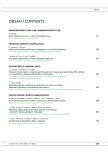Traumatic Brain Injury and Fractures of the Facial Skeleton
Authors:
O. Bulik 1; M. Machálka 1; O. Liberda 1; R. Foltán 3; R. Jura 3; E. Gelnarová 4; T. Pavlík 4
Authors‘ workplace:
Klinika ústní, čelistní a obličejové chirurgi e LF MU a FN Brno
1; Stomatologická klinika 1. LF UK a VFN v Praze
2; Ne urologická klinika LF MU a FN Brno
3; Institut bi ostatistiky a analýz, LF a PřF MU, Brno
4
Published in:
Cesk Slov Neurol N 2008; 71/104(5): 559-564
Category:
Short Communication
Overview
Objective:
To identify the occurrence and severity of brain injury in the case of fractures of the facial skeleton and the relationship between the incidence of brain injuries and the cause of the injury and the location of the fracture.
Sample set and methodology:
The work is based on study of a sample of 762 patients with fractures of the facial skeleton. The incidence of brain injury was analysed in relation to individual types of fractures and various mechanisms by which injury took place.
Results:
Brain injuries occurred in 285 patients with fractures of the facial bones (37.4% of the sample) with severe brain injury (cerebral contusion, intracranial haemorrhage, more severe diffuse axonal injury) occurring in 56 patients (19.6%). Brain injury is most common in head injuries suffered in motor vehicle accidents – 68.5% (74 of 108) and in fractures of both jaws – 65% (26 of 40). Severe brain injury occurs most frequently in combination with a fracture of the upper jaw (73.2%, 41 of 56) and injuries suffered in motor vehicle accidents (43%, 24 of 56).
Conclusion:
The most frequent and most severe brain injuries occur in combination with fractures of the upper jaw as a result of motor vehicle accidents. The severity of brain injury relates to the intensity and location of the impact force and it is not possible to prove a protective effect of the facial bones.
Key words:
traumatic brain injuries – fractures of the facial bones
Sources
1. Cassidy JD, Carroll LJ, Peloso PM, Borg J, von Holst H, Holm L et al. Incidence, risk factors and preventi on of mild tra umatic brain injury: results of the WHO Collaborating Centre Task Force on Mild Tra umatic Brain Injury. J Rehabil Med 2004; 43 (Suppl): 28 – 60.
2. Sivák Š, Kurča E, Jančovič D, Petriščák Š,Kučera P. Náčrt súčasného pohľadu na problematiku ľahkých poranení mozgu so zameraním na dospelú populáci u. Čas Lék čes 2005; 144(7): 445 – 450.
3. Statistické informace [online]. 2004. Ústav zdravotnických informací a statistiky České republiky. Available from www.uzis.cz.
4. Bednařík J, Ambler Z, Ehler E. Lehká mozková poranění a jejich akutní management: přehled so učasného stavu a návrh doporučení. Cesk Slov Ne urol N 2003; 66/ 99(2): 131 – 134.
5. Vos PE, Battistin L, Birbamer G, Gerstenbrand F, Potapov A, Prevec T et al. EFNS guideline on mild tra umatic brain injury: report of an EFNS task force. Eur J Ne urol 2002; 9(3): 207 – 219.
6. Gennarelli TA, Me aney DF. Mechanisms of primary he ad injury. In: Wilkins RH, Rengarchary SS (eds). Ne urosurgery. New York: McGraw - Hill 1996 : 2611 – 2621.
7. Ommaya AK, Goldsmith W, Thiba ult L. Bi omechanics and ne uropathology of adult and paedi atric he ad injury. Br J Ne urosurg 2002; 16(3): 220 – 242.
8. McLe an AJ, Anderson RWG. Bi omechanics of closed he ad injury. In: Reilly P, Bullock R (eds). He ad injury. London: Chapman and Hall 1997 : 25 – 37.
9. Kellerová V, Štefan J. Difuzní axonální poranění I. Cesk Slov Ne urol N 2003; 66/ 99(3): 152 – 160.
10. Kellerová V, Ne uwirth J. Difuzní axonální poranění II. Klinický obraz a di agnostické možnosti. Cesk Slov Ne urol N 2003; 66/ 99(4): 237 – 246.
11. Davidoff G, Jakubowski M, Thomas D, Alpert M. The Spectrum of Closed – He ad Injuri es in Faci al Tra uma Victims: Incidence and Impact. Ann Emerg Med 1988; 17(1): 6 – 9.
12. Cannell H, King JB, Winch RD. He adand faci al injuri es after low - speed motor - cycle accidents. Br J Oral Surg 1982; 20(3): 183 – 191.
13. Keenan HT, Brundage SI, Thompson DC, Mai er RV, Rivara FP. Does the Face Protect the Brain? A case-control study of tra umatic brain injury and faci al fractures. Arch Surg 1999; 134(1): 14 – 17.
14. Practice parameter: the management of concussi on in sports (summary statement). Report of the Qu ality Standards Subcommittee. Ne urology 1997; 48(3): 581 – 585.
15. Luce EA, Tubb TD, Mo ore AM. Revi ew of 1,000 major faci al fractures and associ ated injuri es. Plast Reconst Surg 1979; 63(1): 26 – 30.
16. Lee KF, Wagner LK, Lee YE, Suh JH, Lee SR. The impact - absorbing effects of faci al fractures in closed - he ad injuri es. An analysis of 210 pati ents. J Ne urosurg 1987; 66(4): 542 – 547.
Labels
Paediatric neurology Neurosurgery NeurologyArticle was published in
Czech and Slovak Neurology and Neurosurgery

2008 Issue 5
Most read in this issue
- Lumbar Intradural Disc Herniation Manifesting as Cauda Equina Syndrome – Case Report
- Current Diagnostics and Therapy of Oligodendrogliomas
- Neurological Disorders in Critical Illness
- Neurosarcoidosis: a Rare Case of Sarcoidosis of the Cervical Spinal Cord – Case Report
